Physical Address
304 North Cardinal St.
Dorchester Center, MA 02124
Lung transplantation may offer a longer survival and improved quality of life to patients with end-stage lung disease. Common indications for lung transplantation are listed in Table 13.1 . Bilateral lung transplantation is the norm for cystic fibrosis and is in general the most common form of lung transplantation. Indeed, in 2017, 81% of all lung transplantations were bilateral. Other transplantations include single lung, heart-lung, lung-liver, or living-donor single-lobe transplantation. For adults the median survival is 6.7 years. For patients who survive 1 year after primary transplantation the median survival is 8.9 years. Patients with bilateral lung transplantation have in general a better outcome than patients with single lung transplantation (median survival of 7.8–8.5 vs. 4.8–5.7 years, respectively). ,
| Transplant Procedure | Most Common Indications (%) |
|---|---|
| Adult single lung |
|
| Adult bilateral (double) lung |
|
| Adult heart-lung |
|
| Pediatric lung |
|
Unfortunately, the number of patients who can benefit from lung transplantation is limited by the availability of donor organs. In 2005 a lung allocation score was implemented which determined priority for transplantation by medical urgency and expected outcome. , Allocating lungs for transplantation based on urgency and benefit instead of waiting time was associated with fewer waitlist deaths, more transplants performed, and a change in distribution of recipient diagnoses to patients more likely to die on the waiting list. In 2017, the Organ Procurement and Transplantation Network (OPTN) changed the approach to lung allocation with lungs not being offered anymore to the donation service area and the local area around a hospital but being offered to patients within a 250-nautical-mile radius of the donor hospital. This new way of lung allocation led to a 9-day decrease in median waitlist time, an increase in the median lung allocation score, an increase in the median length of hospital stay from 17 to 19 days, but no difference in the need for pretransplant extracorporeal membrane oxygenation (ECMO) or posttransplant outcomes. Another way to increase the pool of lungs available for transplantation might be the use of ex vivo lung perfusion (EVLP), which has been developed in recent years. , EVLP allows for a more complete assessment of questionable lungs prior to transplantation and for potential treatment and repair of injured lungs.
Complications of lung transplantation may be related to (1) the operation itself (primary graft dysfunction, anastomotic complications), (2) the host’s immunologic response to the allograft (rejection), and (3) the immunosuppressive therapy used to prevent rejection (infection, posttransplantation lymphoproliferative disorders [PTLDs]). Other complications, such as recurrence of the original disease, aspiration, or abnormal medication reaction may also occur. To aid the differential diagnosis, posttransplant time intervals can be divided arbitrarily into immediate (within 4 days), early (4 days to 1 month), and late (beyond 1 month) posttransplantation periods. Differential diagnostic possibilities for each of these periods are listed in Table 13.2 . Most common causes of death within the first 30 days after transplantation include graft failure (22%), non-CMV (cytomegalovirus) infections (17.2%), and multiple organ failure (14.5%) in contrast to death more than 1 to 3 years after transplantation, which is most commonly due to obliterative bronchiolitis (OB)/bronchiolitis obliterans syndrome (BOS) (25.5%) followed by non-CMV infection (20.5%), and graft failure (19.3%) ( Table 13.3 ). Malignancy becomes an important cause of death later on as 8.8% of transplanted patients die of malignancy after 1 to 3 years and 15% at more than 10 years.
| Posttransplantation Period | Operation-Related Complications | Rejection | Immunosuppression-Related Complications | Other Complications |
|---|---|---|---|---|
| Immediate (within 4 days) |
|
Acute antibody-mediated rejection | Bacterial pneumonia | |
| Early (4 days to 1 month) |
|
Acute rejection | Infection (bacterial, viral, fungal) | |
| Late (beyond 1 month) | Large airway stenosis |
|
|
Recurrence of primary disease |
| Cause of Death in %/Time Block | 0–30 Days | 31 Days–1 Year | >1 Year–10 Years | >10 Years |
|---|---|---|---|---|
| Infection, non-CMV | 17.2 | 33.1 | 18.3 | 16.2 |
| Graft failure | 22.0 | 16.1 | 17.9 | 15.4 |
| Obliterative bronchiolitis/bronchiolitis obliterans syndrome | 0.1 | 4.3 | 26.1 | 21.0 |
| Cardiovascular | 13.1 | 5.8 | 5.1 | 6.8 |
| Malignancy, other | 0.2 | 3.1 | 12.0 | 15.0 |
| Technical | 11.7 | 3.2 | 0.7 | 0.6 |
| Acute Rejection | 2.7 | 1.9 | 1.0 | 0.2 |
| Lymphoma | 0.0 | 2.0 | 1.6 | 2.9 |
| CMV | 0.0 | 1.9 | 0.4 | 0.0 |
| Other | 33.0 | 28.6 | 16.9 | 21.9 |
Posttransplantation transbronchial biopsy may be performed for a specific clinical indication or for surveillance of acute rejection. The role of surveillance biopsy in lung transplant patients remains controversial. , At least five pieces of well-expanded alveolated lung parenchyma are required for the assessment of acute rejection. Hematoxylin-eosin-stained slides including at least 3 levels cut from the tissue paraffin block and a connective tissue stain such as Verhoeff-Van Gieson elastic stain or Masson trichrome to evaluate for submucosal small airways fibrosis as seen in OB should be prepared and reviewed. Silver stains such as Grocott methenamine silver stain to search for fungal organisms might be used. Complement 4d (C4d) by immunofluorescence or immunohistochemistry should be done at least if antibody-mediated (humoral) rejection (AMR) is suspected. More recently transbronchial cryobiopsies have also been studied for the use of allograft evaluation because larger biopsy pieces can be obtained that lack the typical crush artifact of forceps biopsies. However, this technique is still under investigation for the indication of allograft evaluation given that only a few centers have experience with that technique and the procedure has a potential for complications.
In the following, important morphologic findings in lung allografts will be discussed and if indicated ancillary testing will be noted. While the vast majority of tissue samples obtained for assessment of rejection and its mimickers are transbronchial biopsies, occasionally a wedge biopsy, an explant specimen for re-transplantation, or autopsy specimens are available for histopathologic review. The acknowledgment of the type of specimen in the pathology report is important given the known patchy findings of rejection or its mimickers in the lung. Therefore, the absence of a morphologic finding does not exclude the possibility of a certain condition and clinicopathologic correlation and correlation with other tests such as cultures and/or PCR for microorganisms of bronchoalveolar lavage fluid or serology for donor-specific antibodies (DSAs) among others is required.
Except for monozygotic twins, donors and recipients are genetically different and express different histocompatibility antigens. As a result, allografts are rejected by the recipient’s immune system. Multiple immunologic processes are involved, creating a spectrum of rejection responses. The currently accepted scheme for grading pulmonary allograft rejection was approved by the International Society of Heart and Lung Transplantation (ISHLT) board of directors in 2007 ( Box 13.1 ).
Acute rejection
Grade A0: none
Grade A1: minimal
Grade A2: mild
Grade A3: moderate
Grade A4: severe
Small airways rejection—lymphocytic bronchiolitis
Grade B0: none
Grade B1R: low grade
Grade B2R: high grade
Grade BX: ungradable
Chronic airways rejection—obliterative bronchiolitis
C0: absent
C1: present
Chronic vascular rejection—accelerated graft vascular sclerosis
Since the 2007 revision a new clinical concept of chronic lung allograft dysfunction (CLAD) has emerged. In addition to obstructive CLAD—also known as BOS—restrictive CLAD or restrictive allograft syndrome (RAS) has also been recognized.
AMR is a difficult subject in lung transplantation and is discussed at the end of this section.
The term acute rejection without a qualifier is used to describe acute cellular rejection. This is a cell-mediated process, in contrast to the antibody-mediated process of AMR. Most lung transplant recipients experience episodes of acute rejection.
Acute rejection may occur as early as 3 days and as late as several years after transplantation. Most acute rejection episodes begin within the first 3 months after transplantation.
Clinical features may include low-grade fever, cough, dyspnea, crackles, and adventitious sounds on auscultation. Features suspicious for rejection include a more than 10% decrease in the forced expiratory volume in 1 minute (FEV1) and hypoxemia. Patients might also have low serum levels of immunosuppressive medication such as sirolimus or tacrolimus.
Radiologic abnormalities include perihilar or lower lung zone alveolar and interstitial infiltrates, septal lines, subpleural edema, peribronchial cuffing, and pleural effusion. In cases of a single-lung transplant, the ventilation-perfusion (V/Q) lung scan will show decreased perfusion to the allograft.
Clinical features may suggest acute cellular rejection, but a transbronchial biopsy is usually required to confirm the diagnosis and rule out mimickers such as infection, reperfusion injury, aspiration, or abnormal medication effect among others. If biopsy from multiple sites is technically impossible, lower lobe biopsies are preferred because they appear to be more informative.
The hallmark of acute rejection is the presence of perivascular mononuclear cell infiltrates. Acute rejection is graded according to the density and extent of the perivascular infiltrates and the presence or absence of secondary pneumocyte damage ( Table 13.4 ). Rejection-type infiltrates usually involve more than one vessel; the final grade is given based on the vessel with the highest-grade rejection. Acute cellular rejection is graded as follows:
Minimal acute rejection (grade A1) is characterized by infrequent two- to three-cell-thick perivascular mononuclear cell infiltrates ( Fig. 13.1 ).
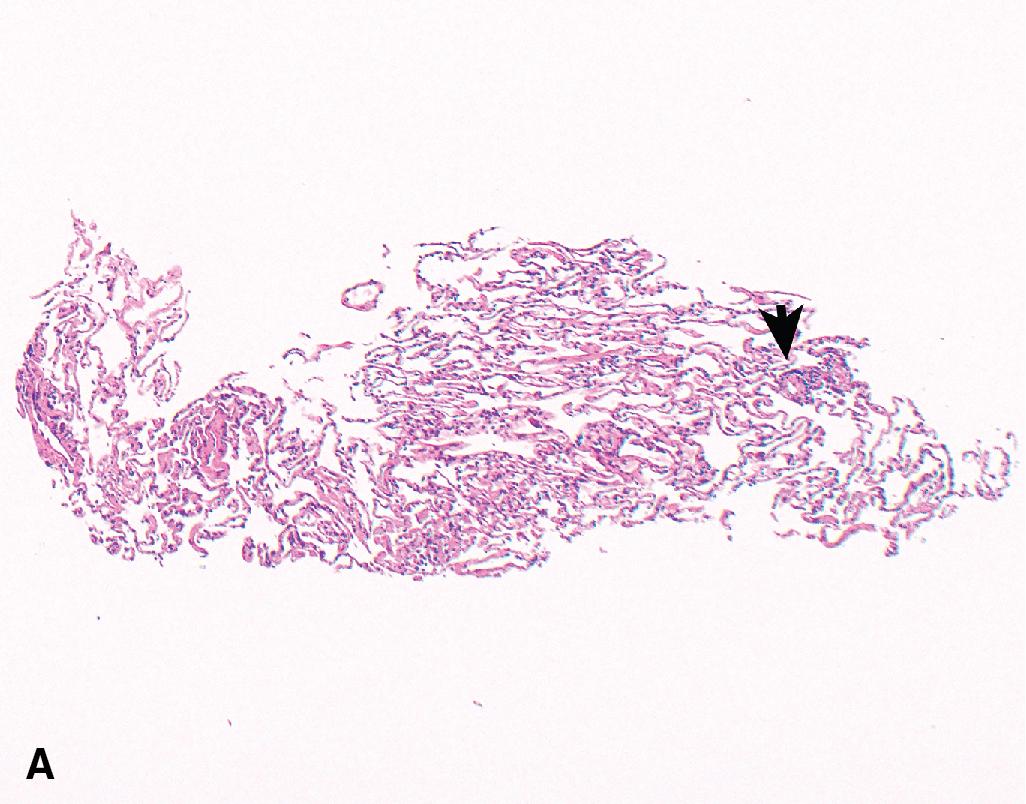
In mild acute rejection (grade A2), the perivascular mononuclear cell infiltrates become thicker, denser, and usually more frequent ( Fig. 13.2 ).
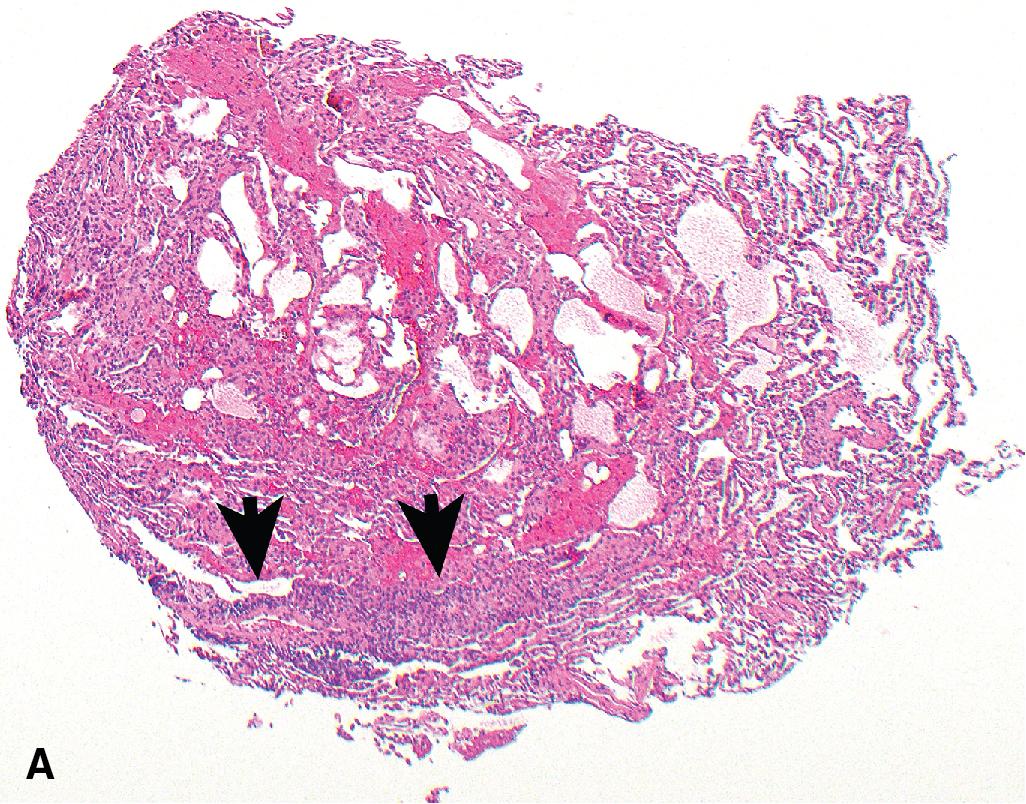
In moderate acute rejection (grade A3), the infiltrates extend into the adjacent interalveolar and peribronchiolar septa and airspaces ( Fig. 13.3 ).
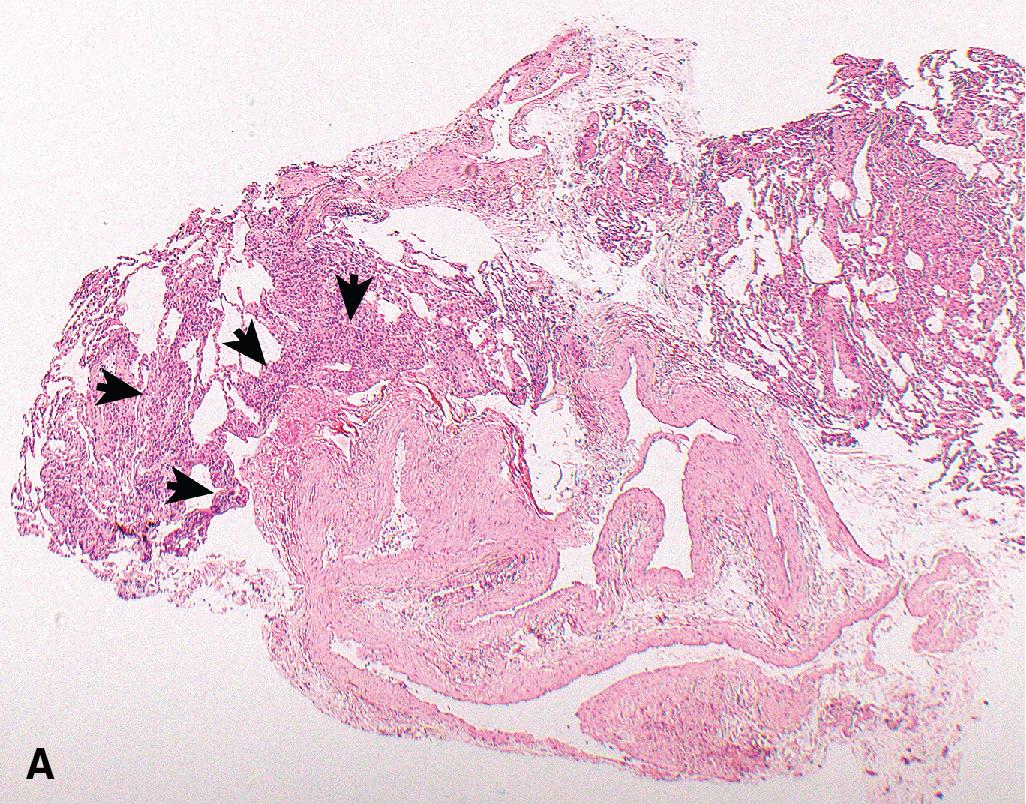
In severe acute rejection (grade A4), the mononuclear cell infiltrates are associated with pneumocyte damage. The latter often manifests as diffuse alveolar damage with hyaline membranes, fibrinous organizing pneumonia or organizing pneumonia might also be seen ( Fig. 13.4 ). There might be a paradoxical diminishing of the perivascular infiltrates (see Fig 13.4 B).
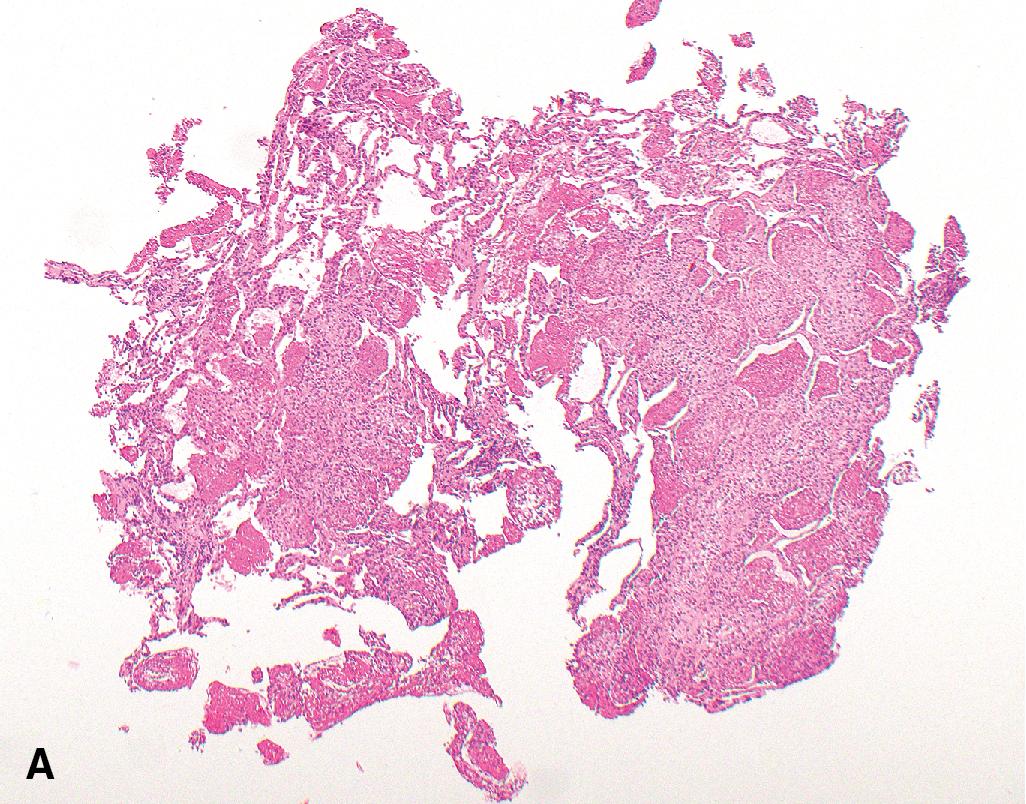
| Grade of Acute Rejection | Histologic Criteria | Cellular Composition | Comments |
|---|---|---|---|
| A0—none | Normal pulmonary parenchyma | ||
| A1—minimal | Perivascular mononuclear cell infiltrates, 2–3 cells thick (not obvious at low magnification) | Small round, plasmacytoid, and transformed lymphocytes | Perivascular infiltrates usually infrequent |
| A2—mild | Perivascular mononuclear cell infiltrates, >3 cells thick (easily seen at low magnification) | Same as A1, with macrophages, and possibly scattered eosinophils |
|
| A3—moderate | Perivascular mononuclear cell infiltrates, similar to A2, with extension into alveolar septa and airspaces | Same as A2, with possible occasional neutrophils | Endothelialitis and airway inflammation are usually present |
| A4—severe | Diffuse and focally perivascular mononuclear cell infiltrates (paradoxic diminishing of perivascular infiltrates), similar to A3, with prominent pneumocyte damage | Same as A3 | Pneumocyte damage commonly associated with hyaline membranes |
The composition of the cellular infiltrates also changes with increasing severity of rejection. In minimal acute rejection, the perivascular infiltrates are composed predominantly of small, round, and plasmacytoid lymphocytes. As the rejection advances in intensity, the infiltrates contain more activated lymphocytes, macrophages, plasma cells, eosinophils, and occasionally neutrophils (see Figs. 13.3 C and 13.4 C). Subendothelial infiltrates become more pronounced. In higher-grade rejection, the inflammatory cells permeate the vessels with extension to the endothelium, giving rise to endothelialitis ( Figs. 13.3 C and 13.5 ). In 30% of mild and 60% of moderate acute rejection, there is also associated airway inflammation.

A rare form of acute rejection also exists; it is characterized by abundant eosinophils, which may obscure the mononuclear cells in the perivascular infiltrates.
Perivascular and interstitial mononuclear cell infiltrates are not specific for acute rejection. Differential diagnostic considerations include infections, especially CMV pneumonia and Pneumocystis jirovecii pneumonia, and posttransplant lymphoproliferative disorders (PTLDs). Some histologic features may favor infection over acute rejection ( Table 13.5 ). Cultures and special stains may be helpful in the diagnosis of mycobacterial and fungal infections. P. jirovecii infections might be identified by fungal stains of tissue sections and reverse transcriptase- polymerase chain reaction (RT-PCR) of the bronchoalveolar lavage (BAL) because this organism does not grow in culture. Viral pneumonias can be confirmed by molecular techniques as well as serologic or immunohistochemical techniques. Eosinophils might also be seen in abnormal medication reaction.
| Histologic Features | Infection Favored |
|---|---|
| Predominant alveolar septal infiltrates as compared to perivascular infiltrates | Any infection |
| Abundant neutrophils | Bacterial pneumonia, CMV pneumonia, Blastomyces pneumonia, or candidiasis |
| Abundant eosinophils | Fungal infection |
| Nuclear or cytoplasmic inclusions | Viral pneumonia |
| Multinucleation | Respiratory syncytial virus or parainfluenza virus pneumonia |
| Punctate zones of necrosis | Herpes simplex virus, varicella zoster virus, or CMV pneumonia |
| Granulomatous inflammation | Mycobacterial, fungal, or Pneumocystis jirovecii infection |
| Frothy intraalveolar exudates | P. jirovecii pneumonia |
In some cases, histologic features of acute rejection and infection coexist. In these cases, the pathologist should attempt to decide which is dominant and guide the clinician by favoring one over the other. Follow-up biopsy after appropriate antimicrobial therapy is also recommended so that any acute rejection component can be reassessed. The differential diagnosis between acute rejection and PTLDs is discussed later.
The treatment of acute rejection typically consists of bolus therapy with intravenous steroids, which may be supplemented by temporary increases in the maintenance immunosuppression regimen. In at least 80% of the cases, acute rejection is successfully treated. However, 15% to 20% of acute rejection episodes persist or recur, presenting a particularly difficult management problem for the clinician. When this occurs, intensified immunosuppression with one or more agents is usually attempted. However, it has been shown that patients with persistent, recurrent, or late (occurring at least 3 months after transplantation) acute rejection are at increased risk for developing chronic airway rejection with an increased risk existing even with minimal acute rejection. ,
Small airways rejection is designated as B grade rejection by the 2007 working formulation and divided into three grades, grade B0 (no small airway inflammation), grade B1R (low-grade) ( Fig. 13.6 ), and grade B2R (high-grade) ( Fig. 13.7 ). “R” stands for “revised grade.” BX is used if small airways cannot be graded. The B grade designation applies only to small airways (bronchioles). Airway inflammation may be a harbinger of chronic airway rejection. ,
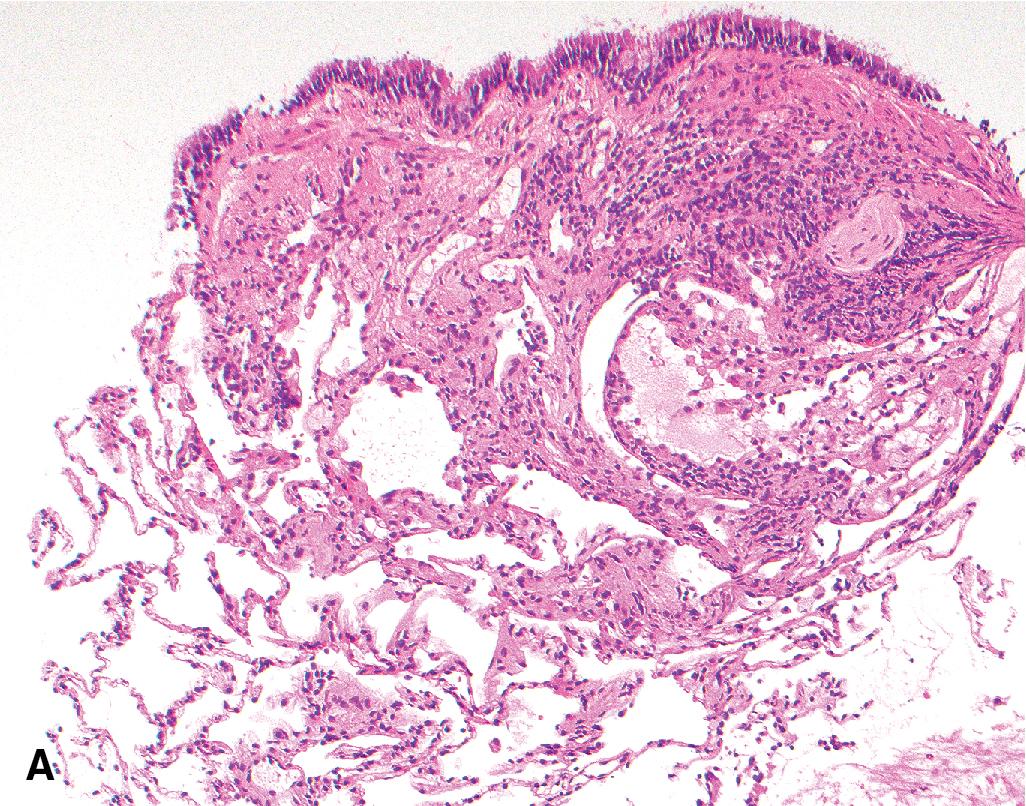
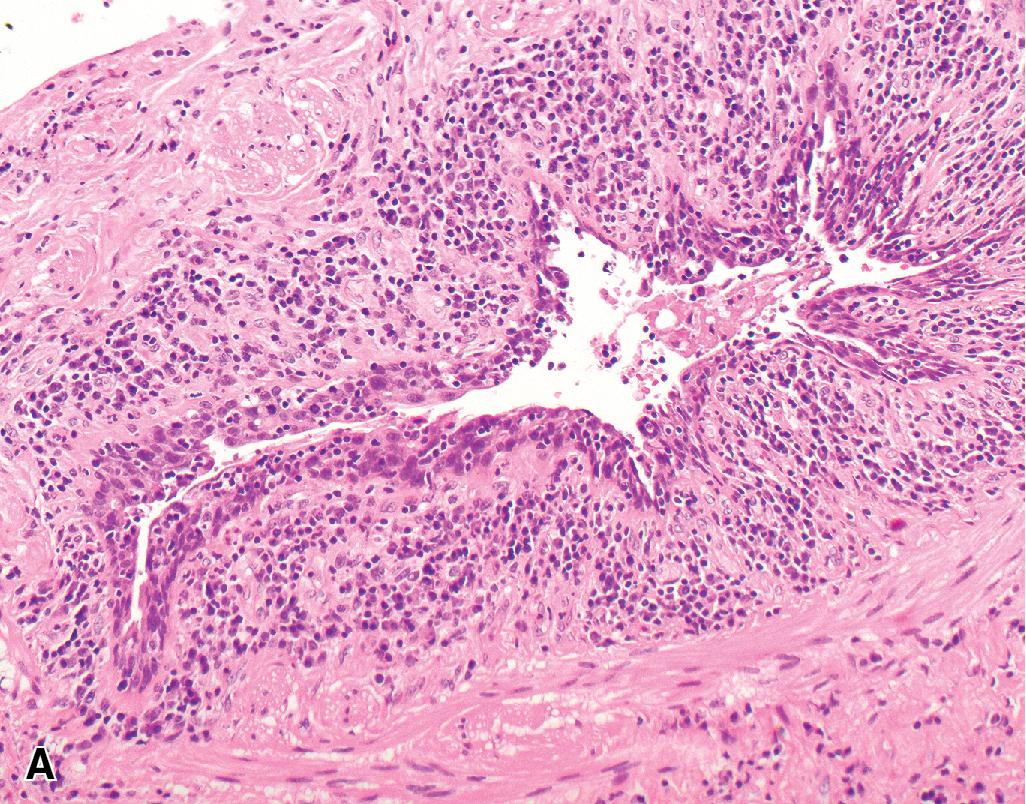
Criteria for grading airway inflammation are listed in Table 13.6 .
| Grade | Small Airways Inflammation |
|---|---|
| B0—no airway inflammation | None |
| B1R—low-grade small airway inflammation |
|
| B2R—high-grade small airway inflammation |
|
| BX—ungradable | Sampling problems (no small airway present), infection, tangential cutting, other problems |
Infection, particularly that caused by viral, bacterial, mycoplasmal, fungal, and chlamydial organisms, may mimic the airway inflammation related to acute rejection.
Obliterative bronchiolitis, also known as chronic airway rejection, obstructive CLAD, and BOS, is the most significant long-term complication of lung transplantation, with a prevalence of 30% to 50%.
Obliterative bronchiolitis is the histologic hallmark of BOS. The terminology is somewhat confusing because obliterative bronchiolitis of chronic airway rejection is usually referred to as bronchiolitis obliterans, or BOS, in the clinical lung transplantation literature. It is important to recognize that obliterative bronchiolitis or bronchiolitis obliterans of chronic airway rejection is both clinically and histologically distinct from the (sub)acute lung injury pattern once known as bronchiolitis obliterans organizing pneumonia (BOOP). To make this distinction clear, the nomenclature has been changed, and the currently preferred term for BOOP is organizing pneumonia . ,
Obliterative bronchiolitis is most frequently diagnosed between 9 and 15 months after transplantation. It rarely develops during the first 3 months but has been reported as early as 2 months after transplantation. The median BOS-free survival time is 4 years for bilateral lung transplanted patients and is significantly shorter at 3.2 years for single lung transplant recipients. Almost all patients who live 10 years posttransplantation will have developed BOS. Obliterative bronchiolitis/BOS is the most common cause of death in patients after 1 year of transplantation accounting for 21% to 29% of all deaths in these patients.
Obliterative bronchiolitis often develops insidiously with vague general symptoms and nonproductive cough. Later, progressive dyspnea on exertion becomes the dominant complaint.
Chest radiographs are typically unremarkable until later in the disease, when a variable pattern of bronchiectasis is accompanied by airway tapering/obliteration and zones of hyperinflation. However, bronchiectasis can also be seen in patients with RAS or patients with combined features of BOS and RAS. These changes reflect the peculiar nature of chronic airway rejection: proximal bronchiectasis (dilatation) with distal obliterative bronchiolitis (constriction).
Given the patchy nature of obliterative bronchiolitis the sensitivity of transbronchial biopsies is relatively low. Therefore clinicians use a decline in FEV1 to diagnose BOS clinically. , Specifically, CLAD including BOS is defined as a decline in FEV1 of 20% or more when compared with a previously established posttransplantation baseline.
The term obliterative bronchiolitis refers to hyalinized fibrous plaques present in the submucosa of small airways. , In early obliterative bronchiolitis there is usually subepithelial fibrous tissue ( Fig. 13.8 ), in late obliterative bronchiolitis the fibrous tissue leads to partial occlusion of the lumen of the small airway and eventually possibly to its obliteration ( Fig. 13.9 ). The scar tissue may be concentric or eccentric and may be associated with destruction of the smooth muscle wall. An elastic stain such as a Verhoeff-Van Gieson stain might help to visualize the elastic lamina of the airway (see Figs. 13.8 B and 13.9 B); a Masson Trichrome stain highlights the scar/fibrotic tissue. Sometimes the scar tissue can be accompanied by chronic inflammation or there might be a prominence of fibroblasts to suggest a more active fibrosis ( Figs. 13.8 and 13.10 ). Overall, obliterative bronchiolitis is designated as grade C1; C0 indicates there is no evidence of obliterative bronchiolitis; CX is used if no small airway is identified in the biopsy or small airways obliteration cannot be assessed due to another reason. Obliterative bronchiolitis often produces morphologic signs of obstruction such as mucostasis or postobstructive (endogenous lipid) pneumonia. ,
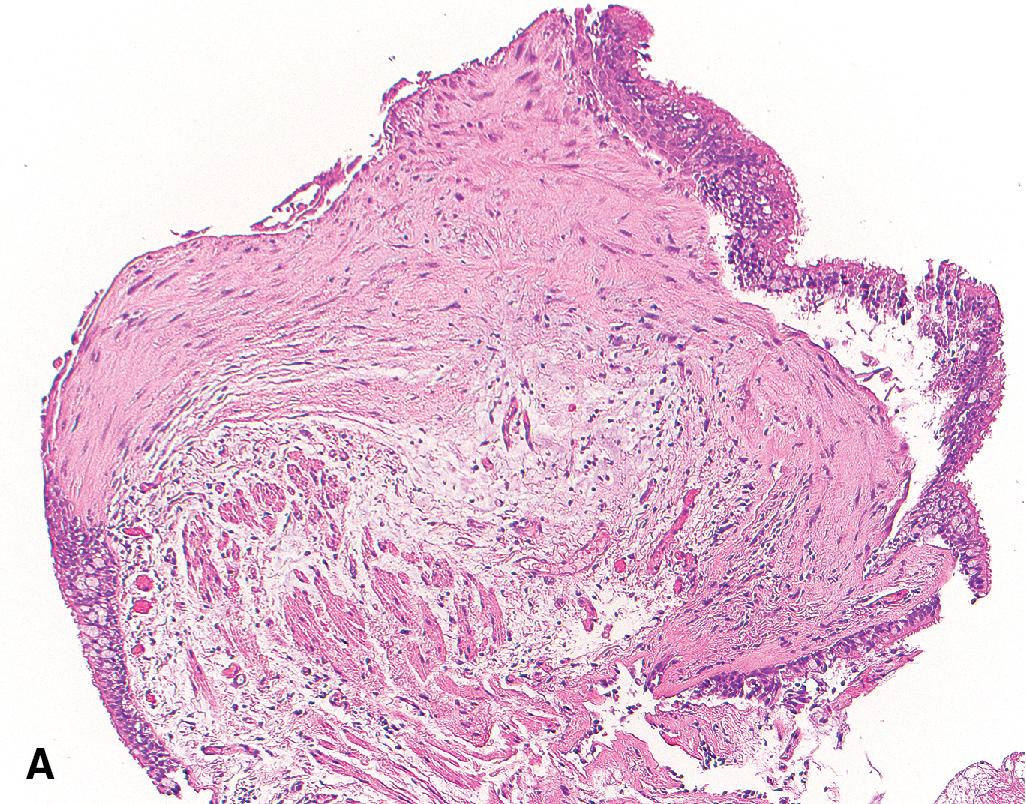
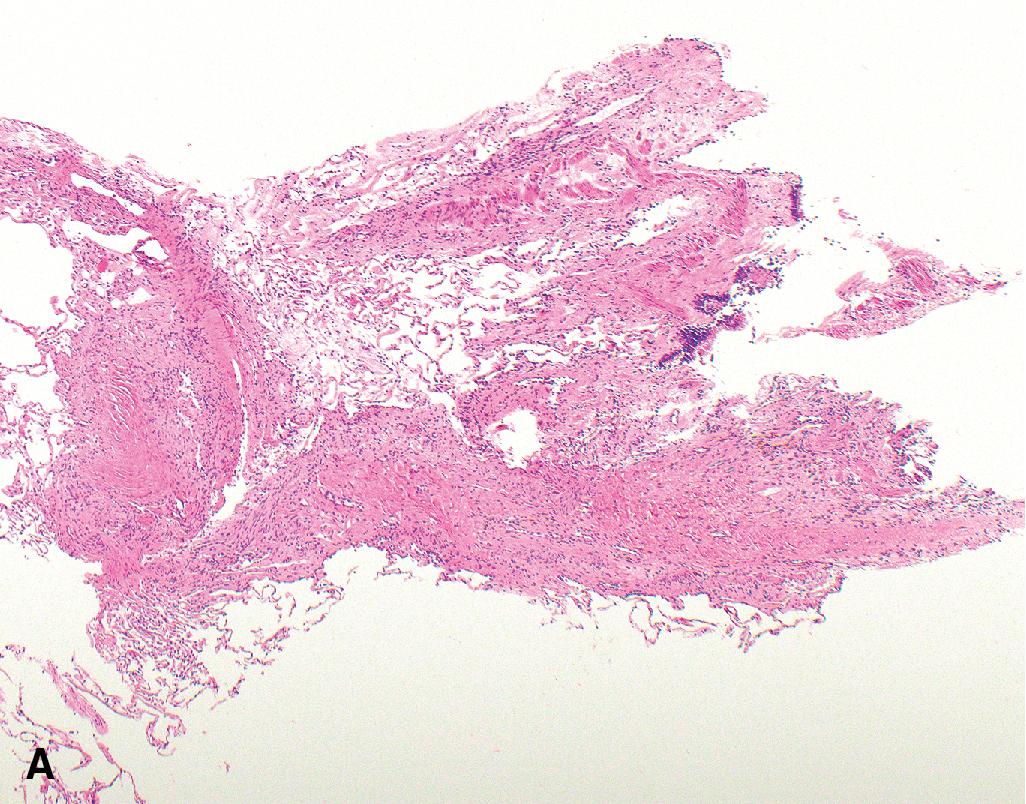
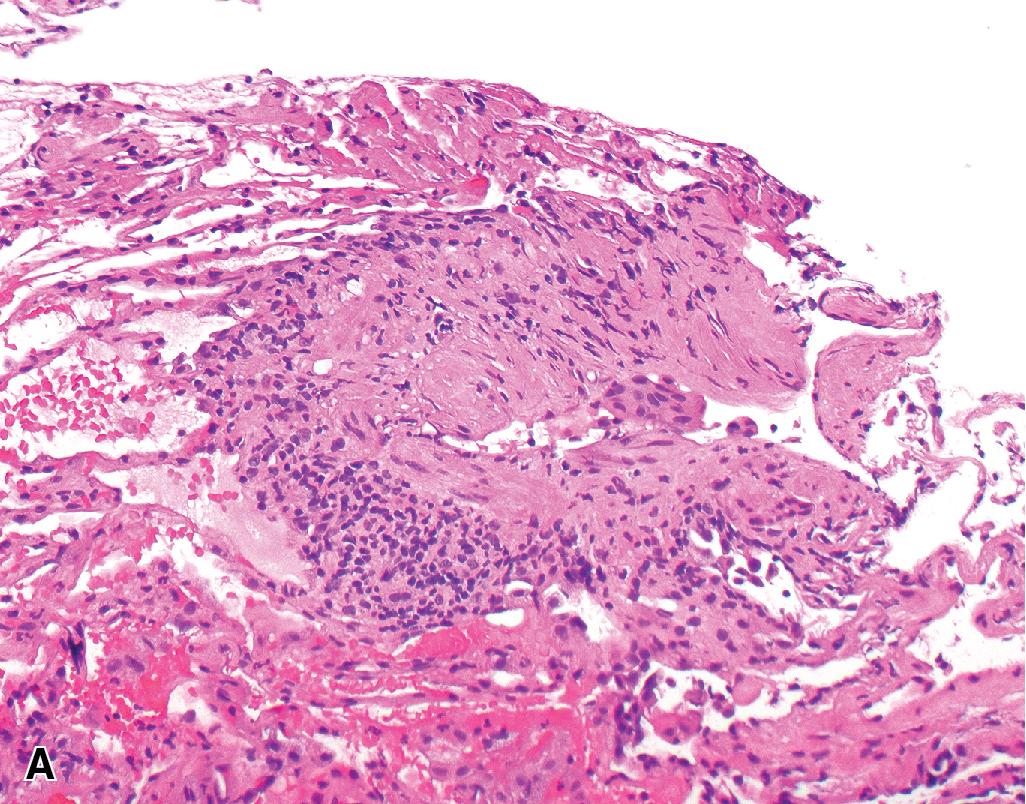
Transplant-related obliterative bronchiolitis involves the small airways. Large airway fibrosis is a nonspecific finding and should not be considered as evidence of chronic airway rejection.
Organizing pneumonia is manifested as plugs of fibromyxoid connective tissue within the lumina of bronchioles and alveoli. These loose, edematous, airspace-filling plugs should be distinguished from the densely eosinophilic submucosal scars of transplant bronchiolitis obliterans.
Augmented immunosuppression appears to be of some benefit in treating obliterative bronchiolitis, but it is far from optimal. It is suggested that cyclosporine be switched to tacrolimus, and a trial of azithromycin is also recommended. , Referral to an experienced surgeon to evaluate the gastroesophageal junction for fundoplication is suggested for patients who also have confirmed gastroesophageal reflux. , Other reported therapeutic options might include total lymphoid irradiation or extracorporeal photosynthesis. However, overall, pharmacologic therapy appears to be of limited efficacy and retransplantation might be the only effective therapy in selected patients. Survival is higher among patients who undergo retransplantation for obliterative bronchiolitis than for those who undergo retransplantation for other reasons, but it is lower compared with patients undergoing primary lung transplantation. Overall, as mentioned earlier, BOS is the most common cause of death of patients after 1 year posttransplantation. Therefore, prevention of BOS is important, which may include prevention of infections, prophylactic treatment with arythromycin, and de novo use of tacrolimus as compared to cyclosporine might be promising. , ,
The clinicopathologic significance of accelerated graft vascular sclerosis or chronic vascular rejection is not entirely clear. However, chronic vascular changes may coincide with the presence of obliterative bronchiolitis in lung transplant recipients and with the presence of accelerated coronary artery disease in combined heart-lung transplant recipients. ,
Accelerated graft vascular sclerosis is not applicable to transbronchial biopsies but may be noted in surgical lung samples.
In accelerated graft vascular sclerosis, there is fibrointimal thickening in arteries and veins ( Figs. 13.11 and 13.12 ). There may also be an “active” inflammatory component consisting of subendothelial, intimal, or medial, predominantly lymphoid mononuclear cell infiltrates.
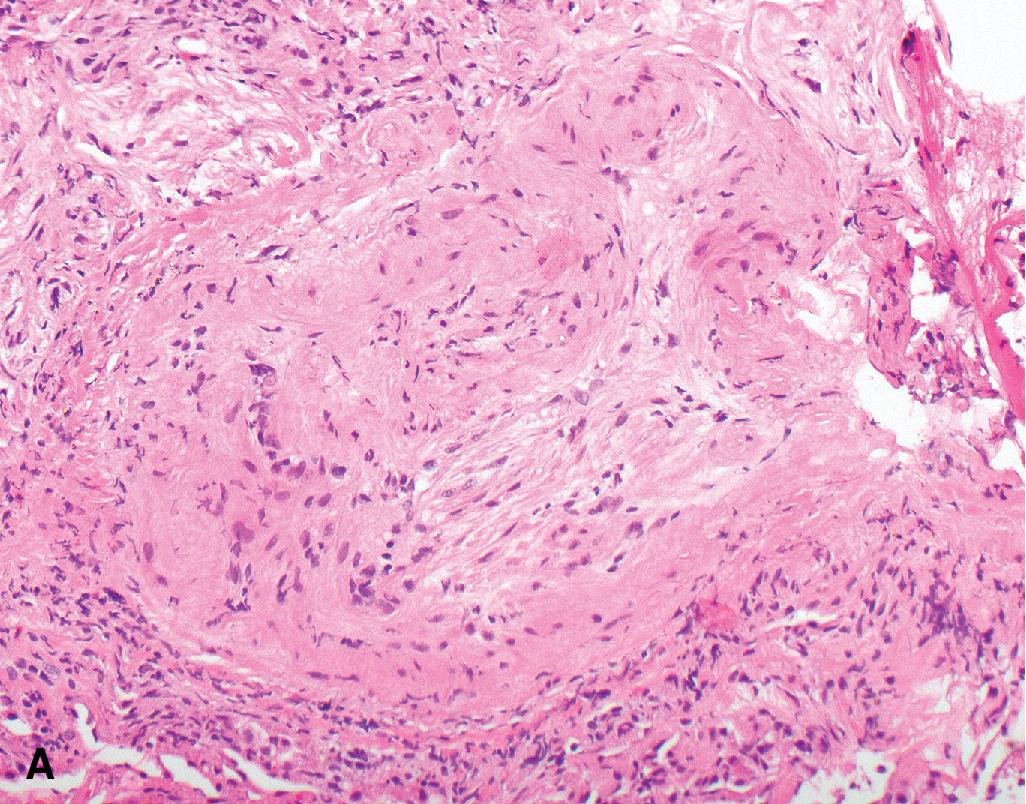
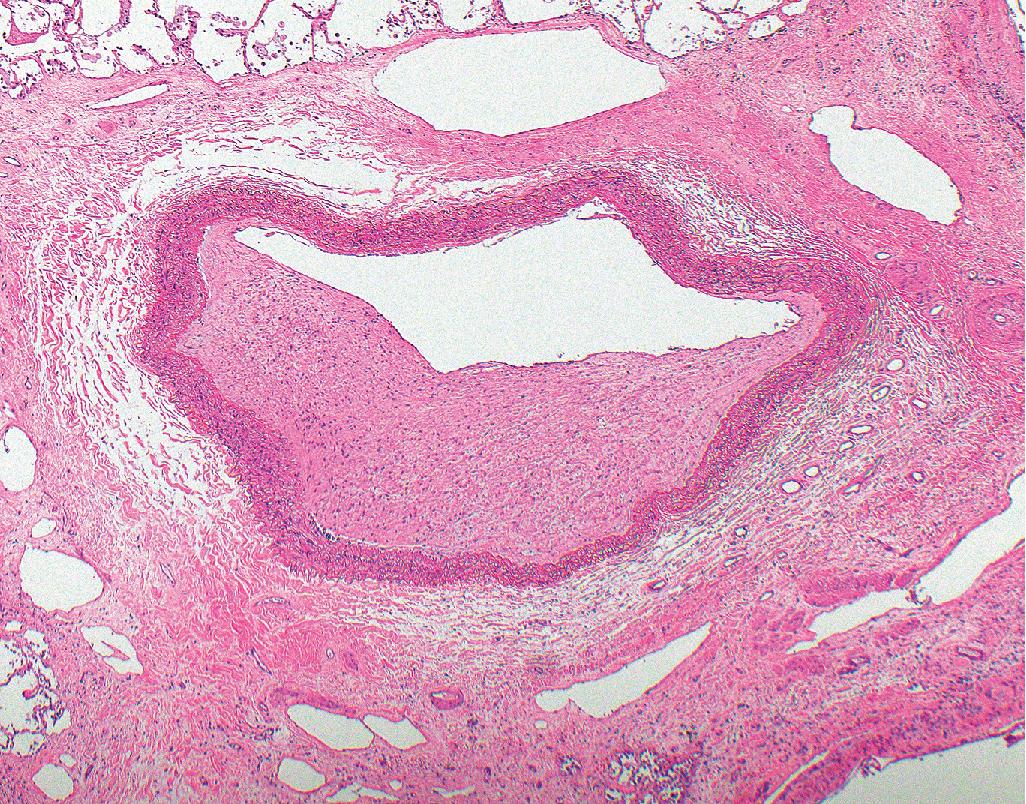
AMR is caused by donor-specific antihuman leukocyte antigen antibodies (DSAs). These antibodies, which may develop before or after transplantation, bind to target antigens and activate the complement system. , Early observations of AMR were based on hyperacute rejection, in which preexistent antibodies lead to complement activation and rapid graft loss. With improved cross-matching before transplantation, the incidence of hyperacute rejection has decreased. On the other hand, improvements in detection of DSA have increased the recognition of AMR after the immediate posttransplant period. Development of posttransplantation DSA is common and is associated with worse clinical outcome.
Donor derived cell-free DNA is a potential biomarker that might aid prediction of the development of AMR when used together with DSA testing. Early diagnosis of AMR may result in better outcomes.
AMR is arbitrarily divided into hyperacute (occurring intraoperatively or within 24 hours of surgery), acute (often mimicking acute rejection), and chronic forms.
AMR can present clinically with measurable allograft dysfunction, such as hypoxemia and decreased FEV1, or might be subclinical, with normal allograft function. , Patients with clinical AMR may have symptoms such as dyspnea, cough, fever, and malaise, or they may be asymptomatic.
Imaging studies may show lung infiltrates.
The diagnosis of pulmonary AMR remains a challenge and requires the correlation of clinical, radiologic, pathologic (including immunostain), serologic, and microbiologic findings. Key diagnostic criteria include lung biopsy findings consistent with AMR (see later), deposition of C4d on the endothelium of capillaries as evaluated by immunostaining, and detection of circulating DSAs. The ISHLT consensus of pulmonary AMR differentiates between clinical AMR, which is associated with allograft dysfunction, and subclinical AMR without dysfunction of the allograft. Each of these two categories is further subdivided into definite, probable and possible AMR based on the presence of all 3 criteria including histologic features suggestive of AMR, C4d deposition, circulating DSA (de novo or preexisting) (definite), 2 of the 3 criteria (probable) or 1 of the 3 criteria (possible) after exclusion of other causes of allograft dysfunction. Therefore, overall allograft dysfunction may bring the attention to AMR but is not required for the diagnosis (clinical vs. subclinical AMR). When there is measurable pulmonary allograft dysfunction, other potential causes of the dysfunction such as infection need to be excluded.
The most common histologic finding described in association with AMR is capillary inflammation, which encompasses neutrophilic capillaritis and neutrophilic margination. , , In 2012 the Pathology Council of the ISHLT proposed some definitions to refine the morphologic spectrum of AMR including neutrophilic margination (increased numbers of neutrophils within septal capillaries but lacking capillary injury, specifically no karyorrhexis), neutrophilic capillaritis (patchy or diffuse septal capillary neutrophilic collections associated with cellular karyorrhectic debris and fibrinous exudates) and acute lung injury with or without hyaline membranes ( Fig. 13.13 A–C). Microvascular thrombi, alveolar hemorrhage, and/or accumulations of neutrophilic infiltrates within adjacent alveolar airspaces might also be seen. Widening of the alveolar septa, as recognized on low magnification, is a first hint of possible AMR and has been observed in all cases of AMR in a recent multi-institutional study. Other patterns reported in AMR include persistent or recurrent high grade acute cellular rejection, lymphocytic bronchiolitis, and obliterative bronchiolitis. However, all of these morphologic findings are insensitive and not specific for AMR by itself.
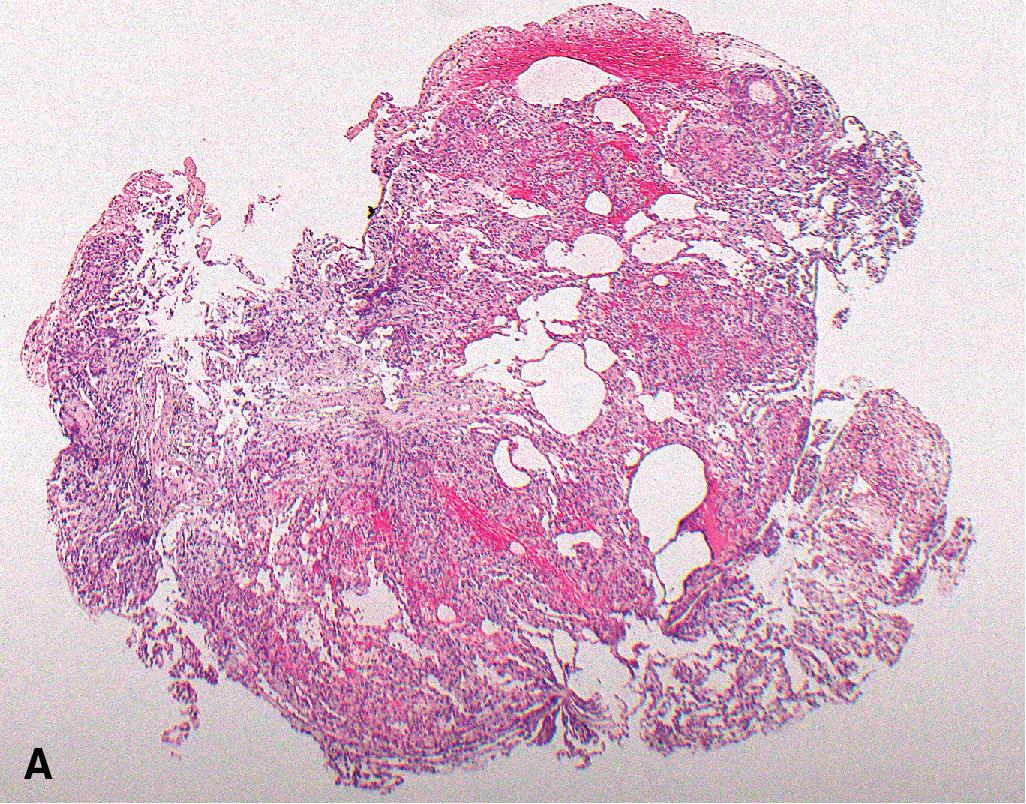
Although it has low sensitivity and specificity in the setting of lung transplantation, immunohistochemistry for C4d may provide supportive evidence for AMR (see Fig. 13.13 D). , , C4d deposition on the endothelium of interstitial capillaries in the lung can be studied using immunoperoxidase and immunofluorescence techniques. Diffuse staining of greater than 50% of the alveolar septal capillaries is considered positive. The interpretation of C4d in the lung might be hampered by nonspecific staining of elastic fibers of large vessels or hyaline membranes. , Furthermore, reproducibility of the interpretation of C4d deposition can be problematic.
Ultrastructural analysis showed higher scores of endothelial cell swelling, endothelial vacuolization, and neutrophilic margination in patients with AMR in contrast to acute cellular rejection and normal lung, however, validation studies are needed.
No histologic findings are specific for AMR. For example, neutrophilic capillaritis, neutrophilic margination, and acute lung injury can also be seen in infection and severe acute cellular rejection. , Morphologic findings described in AMR can also be seen in aspiration, abnormal drug reaction, and preservation injury shortly after transplantation. Therefore it is important that histologic findings be interpreted in a clinicopathologic context and infection be excluded before a diagnosis of AMR is made.
Capillary C4d deposition is also not specific to AMR. While diffuse (>50% of capillaries) or focal (10%–50% of capillaries) staining has been shown in patients with morphologic findings suggestive of AMR, it has also been found in some cases of acute lung injury from other causes including fibrinous pneumonia and diffuse alveolar damage (DAD), in infection, and preservation injury ( Fig. 13.14 ). ,
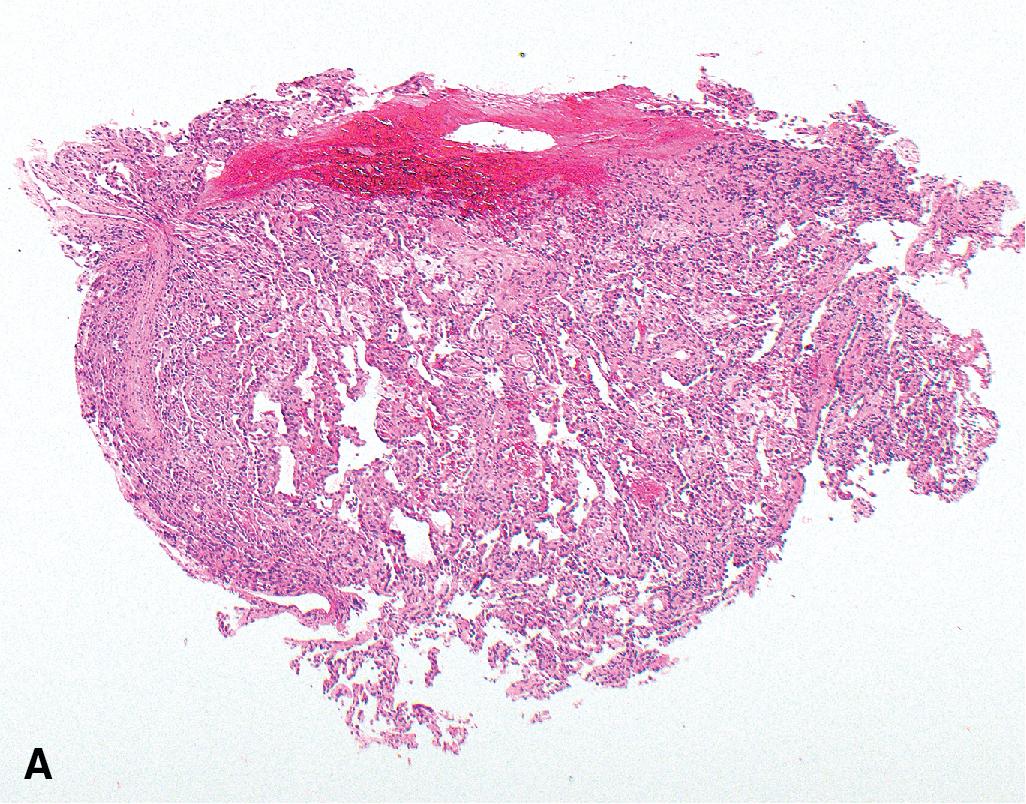
One of the major goals of donor selection is to avoid hyperacute rejection due to preexistent antibodies. Because harmful DSAs can also develop after transplantation, DSA testing should be performed promptly if AMR is suspected.
Overall, the optimal treatment regimen of AMR in the lung is still unknown. Treatment of AMR is focused on antibody depletion. Rituximab, an anti-CD20 monoclonal antibody that causes B cell depletion, might be applied in conjunction with intravenous immunoglobulin (IVIg) and other multimodality treatment. , Proteasome inhibitors have also been used. Plasmapheresis, possibly in conjunction with IVIg with or without bortezomib can also lead to reduction of de novo DSA and clinical improvements. , However, outcomes have been poor with high mortality and high incidence of early CLAD among survivors.
CLAD is defined as a consistent (over at least a 3-month period) 20% or more decline in FEV1 from an established posttransplantation baseline with or without change in forced vital capacity (FVC). Other causes of decline in FEV1 have to be excluded, such as acute infection, acute cellular rejection, AMR, bronchial stenosis, and extra-pulmonary factors. CLAD can occur as obstructive pattern in form of BOS (described earlier in this chapter) or restrictive pattern in form of RAS (see later); commonly, there is a mixture of both obstructive and restrictive patterns. The histologic equivalent of BOS is obliterative bronchiolitis (C-grade rejection); multiple histologic patterns, including pleuroparenchymal fibroelastosis (PPFE), have been described in association with RAS (see later). The PPFE pattern has also been reported as intra-alveolar fibroelastosis (IAFE) in the context of RAS, however, the morphologic features are overall similar (see later). CLAD is the leading cause of death after 1 year posttransplantation with more than 36% of deaths being attributed to it.
Infection, acute rejection, AMR, and aspiration among others are risk factors for acute graft injury and subsequent development of CLAD.
BOS is the obstructive form of CLAD. See earlier under “Obliterative Bronchiolitis.”
RAS is the restrictive CLAD and is defined by a consistent 20% or more decline in FEV1 (with or without a decline in FVC) with a concomitant 10% or more decline in TLC (also compared to posttransplantation baseline) and persistent opacities on chest x-ray or CT. ,
Suspected risk factors for RAS include acute rejection, lymphocytic bronchiolitis, chronic pulmonary infection with Pseudomonas aeruginosa , other infections, increased neutrophils and eosinophils in the BAL, blood eosinophilia, CMV mismatch, certain pretransplant diagnoses such as chronic obstructive pulmonary disease (COPD) and idiopathic pulmonary fibrosis (IPF), DSA, AMR, and late onset DAD. Some of these risk factors might overlap with those of BOS.
Pulmonary allograft recipients surviving for at least 3 months were included in the study of Sato et al. Similar to obliterative bronchiolitis, PPFE is unlikely to occur during the first 3 months after transplantation.
Patients present with insidious or acute onset of shortness of breath, fever, nonproductive cough, pleurisy, chest tightness, and weight loss. A subset of patients presents with acute hypoxemic respiratory failure similar to acute respiratory distress syndrome (ARDS) with rapid deterioration leading to death or requiring retransplantation; other patients might present with recurrent acute exacerbations followed by periods of clinical stability; another subset is identified only on imaging studies, but will follow a steady decline in lung function afterwards.
Chest x-ray and CT scan show persistent opacities. On CT scans, opacities may include ground glass opacities, consolidation, small linear and reticular opacities, and/or volume loss. Overall, persistent (≥3 months) multilobar opacities with or without pleural changes are the hallmark of RAS. When RAS is suspected imaging studies are recommended to be performed as inspiratory thin section HRCT scans without contrast media. Initial reports in 2003 were those of opacities and honeycombing predominantly in the upper lobes on HRCT. Upper lobe fibrosis was also described in a subsequent study in 2005. However, later reports showed an upper lobe predominance of these findings only in a subset of patients (64%); another study did not identify a particular distribution of parenchymal changes between various lung regions. , A subset of patients also showed radiologic signs of small airways disease including air trapping, “tree-in-bud” opacities, centrilobular nodules, airway thickening, and bronchiectasis suggestive of a mixed BOS and RAS phenotype.
RAS is defined as a consistent 20% or more decline in FEV1 (with or without a decline in FVC) with a concomitant 10% or more decline in TLC (also compared with posttransplantation baseline) and persistent opacities on chest x-ray or CT. ,
Become a Clinical Tree membership for Full access and enjoy Unlimited articles
If you are a member. Log in here